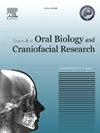Embryonic toxicology evaluation of novel Cissus quadrangularis, bioceramics and tendon extracellular matrix incorporated scaffolds for periodontal bone regeneration using zebrafish model
Q1 Medicine
Journal of oral biology and craniofacial research
Pub Date : 2025-03-25
DOI:10.1016/j.jobcr.2025.03.009
引用次数: 0
Abstract
Introduction
The development of novel scaffold incorporating Cissus quadrangularis extract, bioceramics and tendon extracellular matrix (ECM) for periodontal bone regeneration necessitates a thorough assessment of their embryotoxicity to ensure biocompatibility and safety. This study evaluates the embryonic toxicology of these innovative scaffold using the zebrafish model, which provides a rapid transparent and highly sensitive system for assessing development toxicity.
Materials and methods
Zebrafish embryos were exposed to scaffold containing Cissus quadrangularis extract (80 % ethanol), bioceramics, and tendon extracellular. Briefly, the scaffold immerged in the E3 medium for 48h and the extract (10, 50 and 100μl/ml) was evaluated against developing embryos for different developmental anomalies such as survival, malformation, heartbeat and the expression of RunX2 and Bmp2 genes.
Results
The results showed that the SEM analysis revealed that the membrane was rough in nature. FTIR analysis confirmed the presence of hydroxylate groups, collagen and hydroxyapatite in the synthesized membrane. Meanwhile, the scaffold did not show any of the developmental defects such as hatchability inhibition and neural toxicity. The mortality was comparable to negative control. Further, the study revealed that the scaffold induced the osteogenic potential by elevating the RunX2 and Bmp2 expression.
Conclusion
This study highlighted the inclusion of C. quadrangularis extract could be a beneficial for enhancing periodontal bone regeneration. Further, this also revealed that the extract did not impede the normal tissue development or regeneration using zebrafish embryo as a model.

求助全文
约1分钟内获得全文
求助全文
来源期刊

Journal of oral biology and craniofacial research
Medicine-Otorhinolaryngology
CiteScore
4.90
自引率
0.00%
发文量
133
审稿时长
167 days
期刊介绍:
Journal of Oral Biology and Craniofacial Research (JOBCR)is the official journal of the Craniofacial Research Foundation (CRF). The journal aims to provide a common platform for both clinical and translational research and to promote interdisciplinary sciences in craniofacial region. JOBCR publishes content that includes diseases, injuries and defects in the head, neck, face, jaws and the hard and soft tissues of the mouth and jaws and face region; diagnosis and medical management of diseases specific to the orofacial tissues and of oral manifestations of systemic diseases; studies on identifying populations at risk of oral disease or in need of specific care, and comparing regional, environmental, social, and access similarities and differences in dental care between populations; diseases of the mouth and related structures like salivary glands, temporomandibular joints, facial muscles and perioral skin; biomedical engineering, tissue engineering and stem cells. The journal publishes reviews, commentaries, peer-reviewed original research articles, short communication, and case reports.
 求助内容:
求助内容: 应助结果提醒方式:
应助结果提醒方式:


